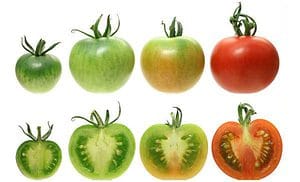A newly published researchers by scientists at University of California Davis and Cornell University explains why beautiful, perfectly ripped tomatoes, that one can typically pick up from a local supermarket, are ironically less tastier than homegrown tomatoes, which look less appetizing.
I had the good fortune of spending most of my early childhood in the countryside, where my grandfolks took care of me. There, besides your usual farm animals, they also catered to a beautifully lush fruit and vegetable garden – they’re still caring to it to this day. There’s no secret to anyone that homegrown veggies are tastier, and now that I’m looking back at . Some say they taste better because they’ve been grown with love. I think that, plus simple genetics.
Heirloom tomatoes are harder to grow than the commercial alternative. This is because they take longer to turn from green to red near the stem as they ripen, causing difficulties in mass production, besides the obvious marking downturn of not being uniformly red. For the past 70 years or so, tomato breeders have been growing a naturally-occurring type that ripens uniformly, turning into a beautiful red from top to bottom. These are now almost unanimously present in supermarkets and are extensively used for producing pasta sauces and ketchup. However, they’re sensibly less testier.
In their study, the scientists, lead by Ann Powell of University of California David, discovered the precise genetic change that causes a tomato to ripen almost perfectly, which also offers a viable explanation for why they’re less tastier.
When the first breeders came by the back then inactive gene, which causes tomatoes to turn an uniform luscious scarlet when ripe, everybody was ecstatic. However, the researchers found that the gene GLK2, causes a tomato’s chloroplasts, which turn the sun’s energy into sugar, to be smaller, fewer, and dispersed evenly throughout the fruit. This means a lower sugar concentration in commercial tomatoes – 10-15 percent less sugar actually. It also reduces the amount of lycopene and other compounds that give a tomato its color, aroma, and nutritional benefits such as antioxidants.
The discovery “is one piece of the puzzle about why the modern tomato stinks,” said Harry Klee, a tomato researcher at the University of Florida in Gainesville who was not involved in the research. “That mutation has been introduced into almost all modern tomatoes. Now we can say that in trying to make the fruit prettier, they reduced some of the important compounds that are linked to flavor.”
Klee is undoubtedly referring to the other conditions under which commercial tomatoes are currently bred and transported. Typically, tomatoes are picked when still green, and then frozen for shipping. Frost/defrost causes a loss in taste and texture.
The researchers hope he findings will get breeders interested in the subject, and tempt some to change the strain to heirloom tomatoes or some wild species.
The study was published in the journal Science.










